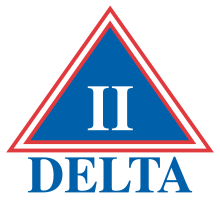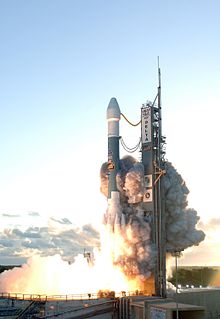 | |
 | |
| Function | Launch vehicle |
|---|---|
| Manufacturer | United Launch Alliance |
| Country of origin | United States |
| Cost per launch | US$51 million in 1987 (7920-10 model)[1] US$137 million in 2018 before retirement [2] |
| Size | |
| Height | 38.9 m (128 ft)[3] |
| Diameter | 2.44 m (8 ft 0 in) |
| Mass | 152,000–286,000 kg (335,000–631,000 lb)[3] |
| Stages | 2 or 3 |
| Capacity | |
| Payload to Low Earth orbit | |
| Mass | 2,800–6,140 kg (6,170–13,540 lb)[3] |
| Payload to Geostationary transfer orbit | |
| Mass | 1,140–2,190 kg (2,510–4,830 lb)[3] |
| Payload to Heliocentric orbit | |
| Mass | 806–1,519 kg (1,777–3,349 lb)[3] |
| Launch history | |
| Status | Retired |
| Launch sites | Cape Canaveral, SLC-17 Vandenberg Air Force Base, SLC-2W |
| Total launches | 155 Delta 6000: 17 Delta 7000: 132 Delta 7000H: 6 |
| Success(es) | 153 Delta 6000: 17 Delta 7000: 130 Delta 7000H: 6 |
| Failure(s) | 1 (Delta 7000) |
| Partial failure(s) | 1 (Delta 7000) |
| First flight |
|
| Last flight | |
| Boosters (6000 Series) – Castor 4A | |
| No. boosters | 9 |
| Powered by | Solid |
| Maximum thrust | 478 kN (107,000 lbf) |
| Specific impulse | 266 s (2.61 km/s) |
| Burn time | 56 seconds |
| Boosters (7000 Series) – GEM 40 | |
| No. boosters | 3, 4, or 9 |
| Powered by | Solid |
| Maximum thrust | 492.9 kN (110,800 lbf) |
| Specific impulse | 274 s (2.69 km/s) |
| Burn time | 64 seconds |
| Boosters (7000 Heavy) – GEM 46 | |
| No. boosters | 9 |
| Powered by | Solid |
| Maximum thrust | 628.3 kN (141,200 lbf) |
| Specific impulse | 278 s (2.73 km/s) |
| Burn time | 76 seconds or 178.03 seconds after lift off |
| First stage – Thor/Delta XLT(-C) | |
| Powered by | 1 RS-27 (6000 series) or RS-27A (7000 series)[4] |
| Maximum thrust | 1,054 kN (237,000 lbf) |
| Specific impulse | 302 s (2.96 km/s) |
| Burn time | 260.5 seconds |
| Propellant | RP-1 / LOX |
| Second stage – Delta K | |
| Powered by | 1 AJ10-118K |
| Maximum thrust | 43.6 kN (9,800 lbf) |
| Specific impulse | 319 s (3.13 km/s) |
| Burn time | 431 seconds |
| Propellant | N2O4 / Aerozine 50 |
| Third stage – PAM-D (optional) | |
| Powered by | Star 48B |
| Maximum thrust | 66 kN (15,000 lbf) |
| Specific impulse | 286 s (2.80 km/s) |
| Burn time | 87 seconds |
Delta II was an expendable launch system, originally designed and built by McDonnell Douglas. Delta II was part of the Delta rocket family and entered service in 1989. Delta II vehicles included the Delta 6000, and the two later Delta 7000 variants ("Lite" and "Heavy"). The rocket flew its final mission ICESat-2 on 15 September 2018, earning the launch vehicle a streak of 100 successful missions in a row, with the last failure being GPS IIR-1 in 1997.[3]
The Delta II series was developed after the 1986 Challenger accident and consisted of the Delta 6000-series and 7000-series, with two variants (Lite and Heavy) of the latter.
The Delta 6000-series introduced the Extra Extended Long Tank first stage, which was 12 feet longer, and the Castor 4A boosters. Six SRBs ignited at takeoff and three ignited in the air.[citation needed]
The Delta 7000-series introduced the RS-27A main engine, which was modified for efficiency at high altitude at some cost to low-altitude performance, and the lighter and more powerful GEM-40 solid boosters from Hercules. The Delta II Med-Lite was a 7000-series with no third stage and fewer strap-ons (often three, sometimes four) that was usually used for small NASA missions. The Delta II Heavy was a Delta II 792X with the enlarged GEM-46 boosters from Delta III.[citation needed]
- ^ "Delta II 7920H-10". Archived from the original on 14 July 2014. Retrieved 1 July 2014.
- ^ "The Annual Compendium of Commercial Space Transportation: 2018" (PDF). Office of Commercial Space Transportation. FAA/AST & Bryce Space and Technology. January 2018. Archived (PDF) from the original on 18 January 2024.
 This article incorporates text from this source, which is in the public domain.
This article incorporates text from this source, which is in the public domain.
- ^ a b c d e f "Delta II Data Sheet". Space Launch Report. Archived from the original on 26 July 2014. Retrieved 9 March 2021.
{{cite web}}: CS1 maint: unfit URL (link) - ^ "Boeing: Integrated Defense Systems - Delta - Delta II Launch Vehicle Family". Archived from the original on 3 November 2006. Retrieved 3 November 2006.
